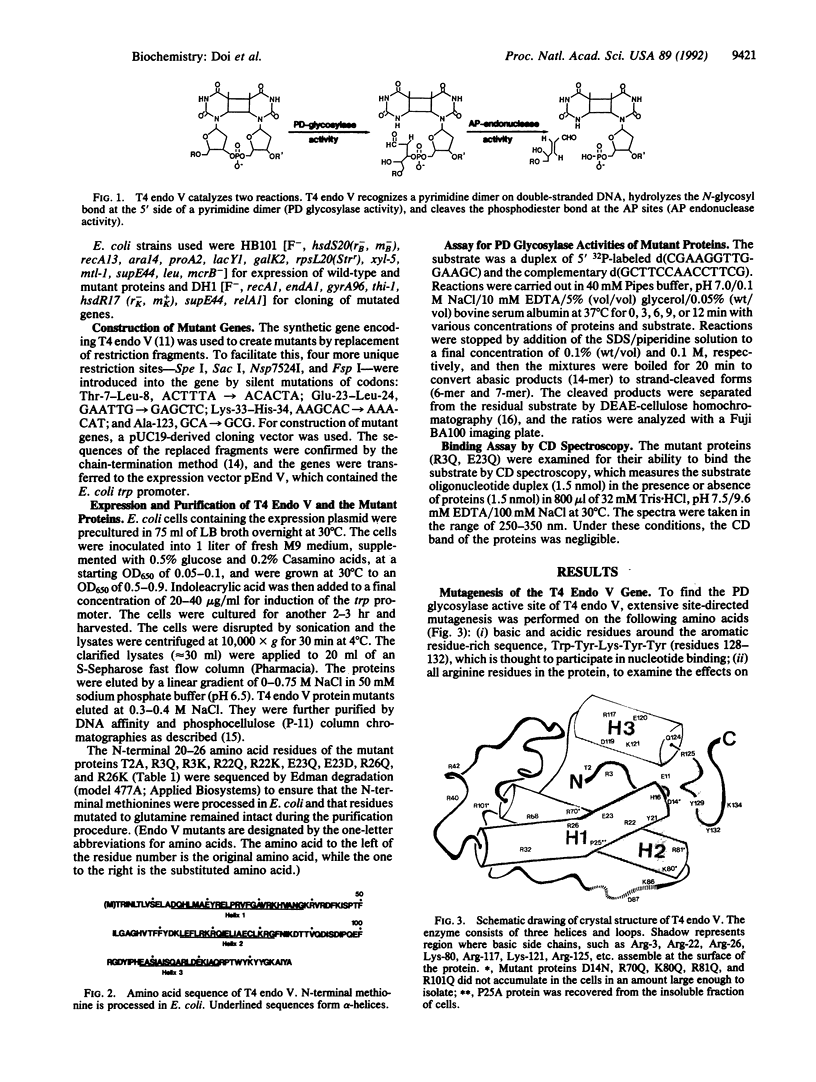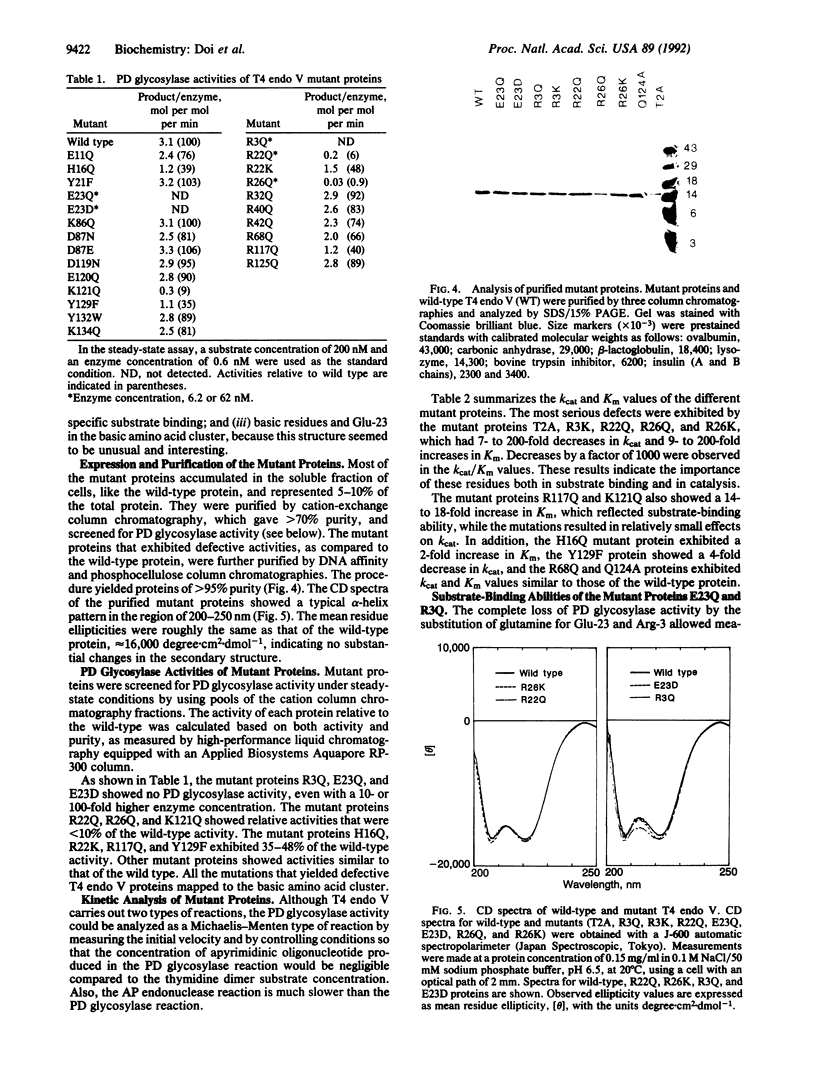Abstract
T4 endonuclease V [endodeoxyribonuclease (pyrimidine dimer); deoxyribonuclease (pyrimidine dimer), EC 3.1.25.1] initiates repair of damaged DNA by hydrolysis of the N-glycosyl bond at the 5' side of a pyrimidine photodimer in double-stranded DNA. To study one of the active sites of T4 endonuclease V, systematic site-directed mutagenesis was performed on the synthetic T4 endonuclease V gene, in parallel with three-dimensional structure analysis by x-ray crystallography. The mutant proteins were evaluated for DNA glycosylase activity using an oligonucleotide duplex (14-mer) containing a single thymidine dimer as a substrate. Replacement of either Glu-23 with glutamine or asparatic acid or Arg-3 with glutamine completely abolished DNA glycosylase activity. Mutation of Arg-3 to lysine or of Arg-26 to glutamine or lysine in a basic amino acid cluster caused serious defects in DNA glycosylase activity, which are reflected in the increases in Km and decreases in kcat of DNA glycosylase activity. On the other hand, substitutions of lysine for Arg-22 or of glutamine for Arg-117 or Lys-121 resulted in increases in the Km value. The completely inactive mutant proteins, E23Q and R3Q, in which glutamine was substituted for Glu-23 and Arg-3, respectively, were further investigated by CD spectroscopy for their ability to bind the oligonucleotide substrate. It was found that the E23Q protein retained specific substrate-binding ability, whereas the R3Q protein did not. These results indicate that Glu-23 plays an important role in catalysis of the DNA glycosylase reaction, and that Arg-3 is a crucial residue for substrate binding. In addition, Arg-22, Arg-26, Arg-117, and Lys-121 in the basic amino acid cluster also participate in substrate binding. We conclude that the basic amino acid cluster in T4 endonuclease V is an essential structure for DNA glycosylase activity.
Full text
PDF




Images in this article
Selected References
These references are in PubMed. This may not be the complete list of references from this article.
- Behmoaras T., Toulme J. J., Helene C. Specific recognition of apurinic sites in DNA by a tryptophan-containing peptide. Proc Natl Acad Sci U S A. 1981 Feb;78(2):926–930. doi: 10.1073/pnas.78.2.926. [DOI] [PMC free article] [PubMed] [Google Scholar]
- Dodson M. L., Lloyd R. S. Structure-function studies of the T4 endonuclease V repair enzyme. Mutat Res. 1989 Sep;218(2):49–65. doi: 10.1016/0921-8777(89)90011-6. [DOI] [PubMed] [Google Scholar]
- Dowd D. R., Lloyd R. S. Biological consequences of a reduction in the non-target DNA scanning capacity of a DNA repair enzyme. J Mol Biol. 1989 Aug 20;208(4):701–707. doi: 10.1016/0022-2836(89)90160-5. [DOI] [PubMed] [Google Scholar]
- Dowd D. R., Lloyd R. S. Biological significance of facilitated diffusion in protein-DNA interactions. Applications to T4 endonuclease V-initiated DNA repair. J Biol Chem. 1990 Feb 25;265(6):3424–3431. [PubMed] [Google Scholar]
- Dowd D. R., Lloyd R. S. Site-directed mutagenesis of the T4 endonuclease V gene: the role of arginine-3 in the target search. Biochemistry. 1989 Oct 31;28(22):8699–8705. doi: 10.1021/bi00448a005. [DOI] [PubMed] [Google Scholar]
- Gruskin E. A., Lloyd R. S. Molecular analysis of plasmid DNA repair within ultraviolet-irradiated Escherichia coli. I. T4 endonuclease V-initiated excision repair. J Biol Chem. 1988 Sep 5;263(25):12728–12737. [PubMed] [Google Scholar]
- Inaoka T., Ishida M., Ohtsuka E. Affinity of single- or double-stranded oligodeoxyribonucleotides containing a thymine photodimer for T4 endonuclease V. J Biol Chem. 1989 Feb 15;264(5):2609–2614. [PubMed] [Google Scholar]
- Ishida M., Kanamori Y., Hori N., Inaoka T., Ohtsuka E. In vitro and in vivo activities of T4 endonuclease V mutants altered in the C-terminal aromatic region. Biochemistry. 1990 Apr 24;29(16):3817–3821. doi: 10.1021/bi00468a002. [DOI] [PubMed] [Google Scholar]
- Jay E., Bambara R., Padmanabhan R., Wu R. DNA sequence analysis: a general, simple and rapid method for sequencing large oligodeoxyribonucleotide fragments by mapping. Nucleic Acids Res. 1974 Mar;1(3):331–353. doi: 10.1093/nar/1.3.331. [DOI] [PMC free article] [PubMed] [Google Scholar]
- Morikawa K., Matsumoto O., Tsujimoto M., Katayanagi K., Ariyoshi M., Doi T., Ikehara M., Inaoka T., Ohtsuka E. X-ray structure of T4 endonuclease V: an excision repair enzyme specific for a pyrimidine dimer. Science. 1992 Apr 24;256(5056):523–526. doi: 10.1126/science.1575827. [DOI] [PubMed] [Google Scholar]
- Morikawa K., Tsujimoto M., Ikehara M., Inaoka T., Ohtsuka E. Preliminary crystallographic study of pyrimidine dimer-specific excision-repair enzyme from bacteriophage T4. J Mol Biol. 1988 Aug 5;202(3):683–684. doi: 10.1016/0022-2836(88)90298-7. [DOI] [PubMed] [Google Scholar]
- Nakabeppu Y., Yamashita K., Sekiguchi M. Purification and characterization of normal and mutant forms of T4 endonuclease V. J Biol Chem. 1982 Mar 10;257(5):2556–2562. [PubMed] [Google Scholar]
- Sanger F., Nicklen S., Coulson A. R. DNA sequencing with chain-terminating inhibitors. Proc Natl Acad Sci U S A. 1977 Dec;74(12):5463–5467. doi: 10.1073/pnas.74.12.5463. [DOI] [PMC free article] [PubMed] [Google Scholar]
- Stump D. G., Lloyd R. S. Site-directed mutagenesis of the T4 endonuclease V gene: role of tyrosine-129 and -131 in pyrimidine dimer-specific binding. Biochemistry. 1988 Mar 22;27(6):1839–1843. doi: 10.1021/bi00406a007. [DOI] [PubMed] [Google Scholar]
- Valerie K., Henderson E. E., deRiel J. K. Identification, physical map location and sequence of the denV gene from bacteriophage T4. Nucleic Acids Res. 1984 Nov 12;12(21):8085–8096. doi: 10.1093/nar/12.21.8085. [DOI] [PMC free article] [PubMed] [Google Scholar]





